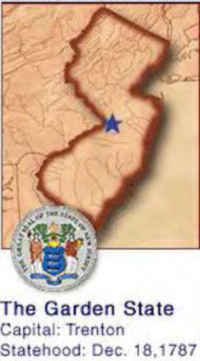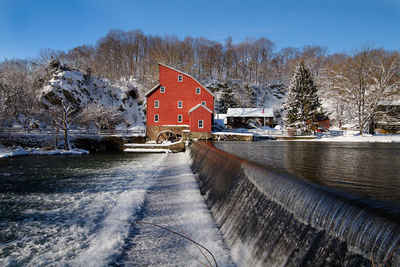New Jersey State Almanac: Facts and Figures
Quick Facts, Figures, and Overview of the State of New Jersey

New Jersey is one of the Middle Atlantic states of the US. New Jersey also has sovereignty over most of Ellis Island, part of the Statue of Liberty National Monument in New York Harbor. New Jersey is a small state bordered by the state of New York on the north and east, by the Atlantic Ocean on the southeast and south, by the US state of Pennsylvania on the west, and by Delaware on the southwest. Sir John Berkley and Sir George Carteret received a royal charter for a colony in the new land and named this colony for the island of Jersey in the English Channel.
Today, New Jersey, an area of wide industrial diversification, is known as the Crossroads of the East. Products from over 20,000 manufacturers can be delivered overnight to 100 million people. The greatest single industry is chemicals; New Jersey is one of the foremost research centers in the world. Many large oil refineries are located in northern New Jersey. Other important manufactured items are pharmaceuticals, instruments, machinery, electrical goods, and apparel. Productive farmland covers about 790,000 acres, 16.7% of New Jersey's land area. The state ranks high in the production of almost all garden vegetables, as well as blueberries, cranberries, and peaches. Poultry, dairy products, and seafood are also top commodities. Tourism is the second-largest industry in New Jersey
New Jersey Almanac: Facts on New Jersey |
|||
|---|---|---|---|
| Official Name | New Jersey | ||
| Capital | Trenton | ||
| Nicknames | The Garden State ...and more | ||
| Motto | Liberty and Prosperity | ||
| Location Region |
40.22340 N, 074.76422 W Middle Atlantic Northeastern |
||
| Constitution Ratified | 1947 | ||
| Statehood | December 18, 1787 3rd state |
||
| Population | 8,791,894 (2010) 1,134.16 sq. mi. 9th |
||
| Largest City (by population) |
10 largest cities (2010 est.): Newark, 277,140; Jersey City, 247,597; Paterson, 146,199; Elizabeth, 124,969; Edison, 99,967; Woodbridge, 99,585; Lakewood, 92,843; Toms River, 91,239; Hamilton, 88,464; Trenton, 84,913 | ||
| Bordering States | North East: New York State East: Atlantic Ocean South: Delaware West and North West: Pennsylvania (Hudson River and New York Bay form part of the state's boundary with New York) (Delaware Bay and the Delaware River form the boundary with Delaware) (Delaware River forms the Pennsylvania boundary) Coastline: 130 mi. |
||
| Major Industry | farming (potatoes, tomatoes, peaches), chemicals, pharmaceuticals, petroleum-based products, insurance, tourism | ||
| Major Rivers | Delaware River, Hudson River | ||
| Major Lakes | none | ||
| New Jersey Counties | 21 Counties in New Jersey | ||
| Largest County (by population) |
Bergen County 905,116 (2010) 234 sq. mi. |
||
| Largest County (by area) |
Burlington County 805 sq. mi. |
||
| State forests | 11 | ||
| State parks | 42 | ||
| Presidential Birthplace | Grover Cleveland was born in Caldwell on March 18, 1837 (he was the 22nd and 24th US President, from 1885 to 1889 and from 1893 to 1897). | ||
| Electoral Votes | 15 | ||
| US Congress | 2 Senators; 13 Representatives | ||
| Time Zone | Eastern Standard Time | ||
| Zip Codes | NANPA | ||
| State Quick Facts | Census Bureau Quick Facts | ||
New Jersey Climate and Weather |
||
|---|---|---|
| New Jersey has relatively warm summers and cold winters, with moderate temperatures in the fall and spring. From June through August, it's common for temperatures to reach the 90s F/32+ C during the day in all parts of the state, though cool sea breezes keep the coast comfortable in a state with fairly high humidity (68% average on the coast, 57% inland). At the shore, when the moist breeze can make it seem chilly despite the mid 60s F/17 C temperatures. Expect rain to be evenly distributed throughout the summer. In the cold winter months New Jersey gets its share of snowstorms, particularly in the higher elevations of the northwestern part of the state, close to the Pocono Mountains of Pennsylvania. Trenton and Newark range from 24 to 41 F/-3 to 5 C in January, while it's 24 to 42 F/-3 to 6 C in Atlantic City. | ||
| Highest Temperature | 110 degrees July 10, 1936 - Runyon |
|
| Lowest Temperature | -34 degrees January 5, 1904 - River Vale |
|
| Avg. Temp: High - Low |
85.6 degrees - 24.2 degrees | |
New Jersey Points of Interest |
||
|
New Jersey is beaches,
casinos, historical sites, gardens and mountains making it a desirable destination for all travelers. Favorite attractions include Atlantic City and the Boardwalk, Battleship New Jersey, Cape May, the Revolutionary War battlefield sites, the Jersey shore, Delaware Water Gap, the Edison National Historic Site in West Orange, Princeton University, Liberty State Park, Jersey City, and the N.J. State Aquarium in Camden, and much more. |
||
New Jersey Highest, Lowest, and Mean Elevations (Feet) |
||
| Mean Elevation: 250 feet | ||
|
Highest Point: High Point: 1,803 feet
|
||
| Lowest Point: | Atlantic Ocean Sea level |
|
New Jersey Land Area (Square Miles) |
||
| Geographic Center | In Mercer County, 5 mi. SE of Trenton Longitude: 74°33.5'W Latitude: 40°4.2'N |
|
| Total Area | 8,721.30 sq. mi 47th |
|
| Land Area | 7,417.34 sq. mi 71.97% |
|
| Water Area | 1,303.96 sq. mi 18.03% |
|
| Forested Land Area | 41.9% | |
| Dimensions (Length - Width) |
150 miles | 70 miles |







 The High Point monument is located
in Montague Township at the highest point in the state of New Jersey. From the parking lot, 1,803 feet above sea level, or the observation deck 220
feet up you can see for miles around. On a clear day you can see New Jersey, New York, and Pennsylvania.
The High Point monument is located
in Montague Township at the highest point in the state of New Jersey. From the parking lot, 1,803 feet above sea level, or the observation deck 220
feet up you can see for miles around. On a clear day you can see New Jersey, New York, and Pennsylvania.